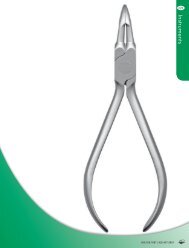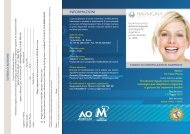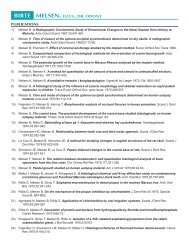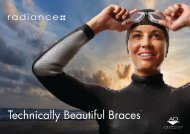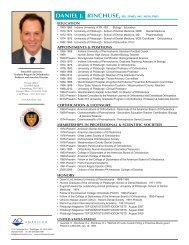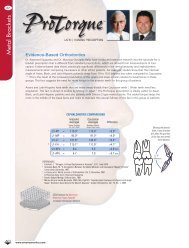Catalog Pages - American Orthodontics
Catalog Pages - American Orthodontics
Catalog Pages - American Orthodontics
You also want an ePaper? Increase the reach of your titles
YUMPU automatically turns print PDFs into web optimized ePapers that Google loves.
Dr. Wick Alexander (center) with (from left to right)<br />
Drs. Chuck, Moody, Cliff, and Moody Alexander.<br />
MINI<br />
TM<br />
master<br />
SERIES<br />
A LEXANDER<br />
LTS<br />
LONG TERM STABILITY<br />
the Alexander Principles System<br />
The Alexander Principles System<br />
In the world of Evidenced Based <strong>Orthodontics</strong>, few systems stand on the<br />
mountain of data that supports the Alexander LTS System. For over 30<br />
years the Alexander Principles have given the doctor the tools to provide<br />
patients quick, beautiful, and stable results. Today, the system shows not<br />
only recent successfully treated cases, but stability over decades.<br />
Beautiful Finish<br />
Just about anyone can fl y a plane, but landing one…that’s a different story. <strong>Orthodontics</strong> is similar. Moving teeth isn’t complicated,<br />
but proper alignment and occlusion is what distinguishes orthodontists as specialists with the knowledge and skill to begin and<br />
fi nish treatment just as a skilled pilot takes off and lands a plane.<br />
The Alexander LTS System embraces the logic of biologically compatible forces, but does so without compromising control. This is<br />
accomplished by using rectangular wire early in treatment while allowing inter-bracket distance to reduce the force. The result is<br />
rapid tooth movement under the complete control of the orthodontist.<br />
The proven Alexander technique allows for a beautiful fi nish with proper occlusion in minimal time.<br />
Stable Finish<br />
What should orthodontic patients expect from their doctor, lifetime retention or lifetime stability? While no one can truly offer<br />
lifetime stability, the skilled orthodontist armed with the proper tools can build a stable foundation that lasts for decades.<br />
The Alexander methodology builds stable results by building the smile on the lower anterior teeth as opposed to the upper “social<br />
six.” By using the wings on the Alexander LTS Bracket, the doctor is able to fi ne-tune rotations, control labial fl aring, separate the<br />
lower incisal roots, and unravel the teeth quickly and precisely. Since the lowers are in place very early in treatment, they settle and<br />
stabilize long before retention is even a consideration.<br />
Alexander LTS System Arch Wire Recommendations<br />
TYPE UPPER LOWER TREATMENT PHASE<br />
.017 x .025 Therma-Ti Lite 857-943A W 857-953A W Initial treatment wire<br />
.016 Force I NiTi 857-506A W 857-516A W Initial treatment wire<br />
.016 x .022 8 Stranded 857-902A 857-912A OPTIONAL Initial treatment wire<br />
.017 x .025 8 Stranded 857-903A 857-913A OPTIONAL Initial treatment wire<br />
.017 x .025 Twist Wire 857-236A 857-256A OPTIONAL Initial treatment wire<br />
.016 Stainless Steel 853-236A W 853-246A W Transitional non-extraction space closure<br />
.016 x .022 Stainless Steel 853-201A W 853-221A W Transitional arch leveling<br />
.016 x .022 Force I NiTi 857-541A W 857-551A W Transitional arch leveling<br />
.017 x .017 Force I NiTi 857-603A W 857-613A W Transitional arch leveling<br />
.017 x .025 Force I NiTi 857-537A W 857-547A W Transitional arch leveling<br />
.017 x .025 Beta Titanium 857-672A W 857-682A W Transitional arch leveling<br />
.019 x .025 Beta Titanium 857-674A W 857-684A W Transitional arch leveling -.022 user<br />
.017 x .025 Stainless Steel 853-204A W 853-224A W Transitional extraction space closure/fi nishing<br />
Add “W” to part number for<br />
individually packaged arch wires<br />
.019 x .025 Stainless Steel 853-207A W 853-227A W Transitional extraction space closure/fi nishing - .022 User<br />
W<br />
800.558.7687 | 920.457.5051<br />
53<br />
Metal Brackets



